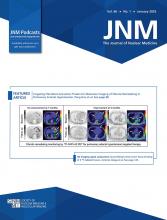Visual Abstract
Abstract
Our laboratory recently developed [11C]PS13 as a PET radioligand to selectively measure cyclooxygenase-1 (COX-1). The cyclooxygenase enzyme family converts arachidonic acid into prostaglandins and thromboxanes, which mediate inflammation. The total brain uptake of [11C]PS13, which is composed of both specific binding and background uptake, can be accurately quantified with gold standard methods of compartmental modeling. This study sought to quantify the specific binding of [11C]PS13 to COX-1 in healthy human brain using scans performed with arterial input function at baseline and after blockade by the COX-1–selective inhibitor ketoprofen. Methods: Eight healthy volunteers underwent two 90-min [11C]PS13 PET scans with radiometabolite-corrected arterial input function, at baseline and about 2 h after oral administration of ketoprofen (75 mg). Results: Two-tissue compartment modeling effectively identified the total uptake of radioactivity in the brain (as distribution volume), showing the highest densities in the hippocampus, the occipital cortex, and the banks of the central sulcus. All brain regions exhibited displaceable and specific binding, and thus none could be used as a reference region. Ketoprofen blocked approximately 84% of the binding sites on COX-1 in the whole brain. After full occupancy was extrapolated, the average whole-brain values of [11C]PS13 were 1.6 ± 0.8 mL·cm−3 for specific uptake, 1.7 ± 0.6 mL·cm−3 for background uptake, and 1.1 ± 0.5 for the specific-to-background ratio. The hippocampus had the highest specific-to-background ratio value of 2.7 ± 0.9. Conclusion: [11C]PS13 exhibited high specific binding to COX-1 in the human brain, but its quantification requires arterial blood sampling.
Footnotes
Published online Nov. 14, 2024.
- © 2025 by the Society of Nuclear Medicine and Molecular Imaging.
This article requires a subscription to view the full text. If you have a subscription you may use the login form below to view the article. Access to this article can also be purchased.
SNMMI members
Login to the site using your SNMMI member credentials
Individuals
Login as an individual user








